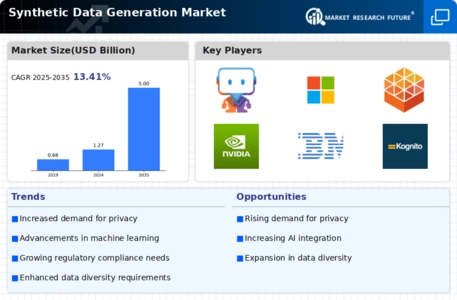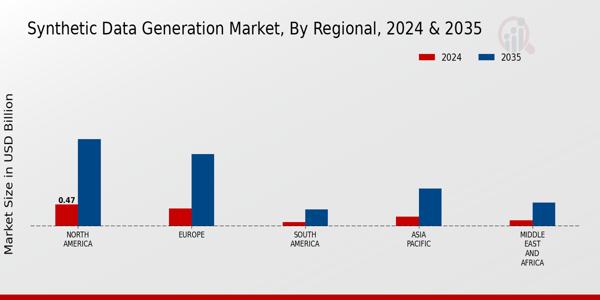Machine Learning
Computer Vision
Natural Language Processing
Data Privacy Protection
Image Data
Text Data
Tabular Data
Video Data
On-Premises
Cloud-Based
Healthcare
Automotive
Finance
Retail
North America
Europe
South America
Asia Pacific
Middle East and Africa
North America Outlook (USD Billion, 2019-2035)
North America Synthetic Data Generation Market by Application Type
Machine Learning
Computer Vision
Natural Language Processing
Data Privacy Protection
North America Synthetic Data Generation Market by Type
Image Data
Text Data
Tabular Data
Video Data
North America Synthetic Data Generation Market by Deployment Type
On-Premises
Cloud-Based
North America Synthetic Data Generation Market by End Use Type
Healthcare
Automotive
Finance
Retail
North America Synthetic Data Generation Market by Regional Type
US
Canada
US Outlook (USD Billion, 2019-2035)
US Synthetic Data Generation Market by Application Type
Machine Learning
Computer Vision
Natural Language Processing
Data Privacy Protection
US Synthetic Data Generation Market by Type
Image Data
Text Data
Tabular Data
Video Data
US Synthetic Data Generation Market by Deployment Type
On-Premises
Cloud-Based
US Synthetic Data Generation Market by End Use Type
Healthcare
Automotive
Finance
Retail
CANADA Outlook (USD Billion, 2019-2035)
CANADA Synthetic Data Generation Market by Application Type
Machine Learning
Computer Vision
Natural Language Processing
Data Privacy Protection
CANADA Synthetic Data Generation Market by Type
Image Data
Text Data
Tabular Data
Video Data
CANADA Synthetic Data Generation Market by Deployment Type
On-Premises
Cloud-Based
CANADA Synthetic Data Generation Market by End Use Type
Healthcare
Automotive
Finance
Retail
Europe Outlook (USD Billion, 2019-2035)
Europe Synthetic Data Generation Market by Application Type
Machine Learning
Computer Vision
Natural Language Processing
Data Privacy Protection
Europe Synthetic Data Generation Market by Type
Image Data
Text Data
Tabular Data
Video Data
Europe Synthetic Data Generation Market by Deployment Type
On-Premises
Cloud-Based
Europe Synthetic Data Generation Market by End Use Type
Healthcare
Automotive
Finance
Retail
Europe Synthetic Data Generation Market by Regional Type
Germany
UK
France
Russia
Italy
Spain
Rest of Europe
GERMANY Outlook (USD Billion, 2019-2035)
GERMANY Synthetic Data Generation Market by Application Type
Machine Learning
Computer Vision
Natural Language Processing
Data Privacy Protection
GERMANY Synthetic Data Generation Market by Type
Image Data
Text Data
Tabular Data
Video Data
GERMANY Synthetic Data Generation Market by Deployment Type
On-Premises
Cloud-Based
GERMANY Synthetic Data Generation Market by End Use Type
Healthcare
Automotive
Finance
Retail
UK Outlook (USD Billion, 2019-2035)
UK Synthetic Data Generation Market by Application Type
Machine Learning
Computer Vision
Natural Language Processing
Data Privacy Protection
UK Synthetic Data Generation Market by Type
Image Data
Text Data
Tabular Data
Video Data
UK Synthetic Data Generation Market by Deployment Type
On-Premises
Cloud-Based
UK Synthetic Data Generation Market by End Use Type
Healthcare
Automotive
Finance
Retail
FRANCE Outlook (USD Billion, 2019-2035)
FRANCE Synthetic Data Generation Market by Application Type
Machine Learning
Computer Vision
Natural Language Processing
Data Privacy Protection
FRANCE Synthetic Data Generation Market by Type
Image Data
Text Data
Tabular Data
Video Data
FRANCE Synthetic Data Generation Market by Deployment Type
On-Premises
Cloud-Based
FRANCE Synthetic Data Generation Market by End Use Type
Healthcare
Automotive
Finance
Retail
RUSSIA Outlook (USD Billion, 2019-2035)
RUSSIA Synthetic Data Generation Market by Application Type
Machine Learning
Computer Vision
Natural Language Processing
Data Privacy Protection
RUSSIA Synthetic Data Generation Market by Type
Image Data
Text Data
Tabular Data
Video Data
RUSSIA Synthetic Data Generation Market by Deployment Type
On-Premises
Cloud-Based
RUSSIA Synthetic Data Generation Market by End Use Type
Healthcare
Automotive
Finance
Retail
ITALY Outlook (USD Billion, 2019-2035)
ITALY Synthetic Data Generation Market by Application Type
Machine Learning
Computer Vision
Natural Language Processing
Data Privacy Protection
ITALY Synthetic Data Generation Market by Type
Image Data
Text Data
Tabular Data
Video Data
ITALY Synthetic Data Generation Market by Deployment Type
On-Premises
Cloud-Based
ITALY Synthetic Data Generation Market by End Use Type
Healthcare
Automotive
Finance
Retail
SPAIN Outlook (USD Billion, 2019-2035)
SPAIN Synthetic Data Generation Market by Application Type
Machine Learning
Computer Vision
Natural Language Processing
Data Privacy Protection
SPAIN Synthetic Data Generation Market by Type
Image Data
Text Data
Tabular Data
Video Data
SPAIN Synthetic Data Generation Market by Deployment Type
On-Premises
Cloud-Based
SPAIN Synthetic Data Generation Market by End Use Type
Healthcare
Automotive
Finance
Retail
REST OF EUROPE Outlook (USD Billion, 2019-2035)
REST OF EUROPE Synthetic Data Generation Market by Application Type
Machine Learning
Computer Vision
Natural Language Processing
Data Privacy Protection
REST OF EUROPE Synthetic Data Generation Market by Type
Image Data
Text Data
Tabular Data
Video Data
REST OF EUROPE Synthetic Data Generation Market by Deployment Type
On-Premises
Cloud-Based
REST OF EUROPE Synthetic Data Generation Market by End Use Type
Healthcare
Automotive
Finance
Retail
APAC Outlook (USD Billion, 2019-2035)
APAC Synthetic Data Generation Market by Application Type
Machine Learning
Computer Vision
Natural Language Processing
Data Privacy Protection
APAC Synthetic Data Generation Market by Type
Image Data
Text Data
Tabular Data
Video Data
APAC Synthetic Data Generation Market by Deployment Type
On-Premises
Cloud-Based
APAC Synthetic Data Generation Market by End Use Type
Healthcare
Automotive
Finance
Retail
APAC Synthetic Data Generation Market by Regional Type
China
India
Japan
South Korea
Malaysia
Thailand
Indonesia
Rest of APAC
CHINA Outlook (USD Billion, 2019-2035)
CHINA Synthetic Data Generation Market by Application Type
Machine Learning
Computer Vision
Natural Language Processing
Data Privacy Protection
CHINA Synthetic Data Generation Market by Type
Image Data
Text Data
Tabular Data
Video Data
CHINA Synthetic Data Generation Market by Deployment Type
On-Premises
Cloud-Based
CHINA Synthetic Data Generation Market by End Use Type
Healthcare
Automotive
Finance
Retail
INDIA Outlook (USD Billion, 2019-2035)
INDIA Synthetic Data Generation Market by Application Type
Machine Learning
Computer Vision
Natural Language Processing
Data Privacy Protection
INDIA Synthetic Data Generation Market by Type
Image Data
Text Data
Tabular Data
Video Data
INDIA Synthetic Data Generation Market by Deployment Type
On-Premises
Cloud-Based
INDIA Synthetic Data Generation Market by End Use Type
Healthcare
Automotive
Finance
Retail
JAPAN Outlook (USD Billion, 2019-2035)
JAPAN Synthetic Data Generation Market by Application Type
Machine Learning
Computer Vision
Natural Language Processing
Data Privacy Protection
JAPAN Synthetic Data Generation Market by Type
Image Data
Text Data
Tabular Data
Video Data
JAPAN Synthetic Data Generation Market by Deployment Type
On-Premises
Cloud-Based
JAPAN Synthetic Data Generation Market by End Use Type
Healthcare
Automotive
Finance
Retail
SOUTH KOREA Outlook (USD Billion, 2019-2035)
SOUTH KOREA Synthetic Data Generation Market by Application Type
Machine Learning
Computer Vision
Natural Language Processing
Data Privacy Protection
SOUTH KOREA Synthetic Data Generation Market by Type
Image Data
Text Data
Tabular Data
Video Data
SOUTH KOREA Synthetic Data Generation Market by Deployment Type
On-Premises
Cloud-Based
SOUTH KOREA Synthetic Data Generation Market by End Use Type
Healthcare
Automotive
Finance
Retail
MALAYSIA Outlook (USD Billion, 2019-2035)
MALAYSIA Synthetic Data Generation Market by Application Type
Machine Learning
Computer Vision
Natural Language Processing
Data Privacy Protection
MALAYSIA Synthetic Data Generation Market by Type
Image Data
Text Data
Tabular Data
Video Data
MALAYSIA Synthetic Data Generation Market by Deployment Type
On-Premises
Cloud-Based
MALAYSIA Synthetic Data Generation Market by End Use Type
Healthcare
Automotive
Finance
Retail
THAILAND Outlook (USD Billion, 2019-2035)
THAILAND Synthetic Data Generation Market by Application Type
Machine Learning
Computer Vision
Natural Language Processing
Data Privacy Protection
THAILAND Synthetic Data Generation Market by Type
Image Data
Text Data
Tabular Data
Video Data
THAILAND Synthetic Data Generation Market by Deployment Type
On-Premises
Cloud-Based
THAILAND Synthetic Data Generation Market by End Use Type
Healthcare
Automotive
Finance
Retail
INDONESIA Outlook (USD Billion, 2019-2035)
INDONESIA Synthetic Data Generation Market by Application Type
Machine Learning
Computer Vision
Natural Language Processing
Data Privacy Protection
INDONESIA Synthetic Data Generation Market by Type
Image Data
Text Data
Tabular Data
Video Data
INDONESIA Synthetic Data Generation Market by Deployment Type
On-Premises
Cloud-Based
INDONESIA Synthetic Data Generation Market by End Use Type
Healthcare
Automotive
Finance
Retail
REST OF APAC Outlook (USD Billion, 2019-2035)
REST OF APAC Synthetic Data Generation Market by Application Type
Machine Learning
Computer Vision
Natural Language Processing
Data Privacy Protection
REST OF APAC Synthetic Data Generation Market by Type
Image Data
Text Data
Tabular Data
Video Data
REST OF APAC Synthetic Data Generation Market by Deployment Type
On-Premises
Cloud-Based
REST OF APAC Synthetic Data Generation Market by End Use Type
Healthcare
Automotive
Finance
Retail
South America Outlook (USD Billion, 2019-2035)
South America Synthetic Data Generation Market by Application Type
Machine Learning
Computer Vision
Natural Language Processing
Data Privacy Protection
South America Synthetic Data Generation Market by Type
Image Data
Text Data
Tabular Data
Video Data
South America Synthetic Data Generation Market by Deployment Type
On-Premises
Cloud-Based
South America Synthetic Data Generation Market by End Use Type
Healthcare
Automotive
Finance
Retail
South America Synthetic Data Generation Market by Regional Type
Brazil
Mexico
Argentina
Rest of South America
BRAZIL Outlook (USD Billion, 2019-2035)
BRAZIL Synthetic Data Generation Market by Application Type
Machine Learning
Computer Vision
Natural Language Processing
Data Privacy Protection
BRAZIL Synthetic Data Generation Market by Type
Image Data
Text Data
Tabular Data
Video Data
BRAZIL Synthetic Data Generation Market by Deployment Type
On-Premises
Cloud-Based
BRAZIL Synthetic Data Generation Market by End Use Type
Healthcare
Automotive
Finance
Retail
MEXICO Outlook (USD Billion, 2019-2035)
MEXICO Synthetic Data Generation Market by Application Type
Machine Learning
Computer Vision
Natural Language Processing
Data Privacy Protection
MEXICO Synthetic Data Generation Market by Type
Image Data
Text Data
Tabular Data
Video Data
MEXICO Synthetic Data Generation Market by Deployment Type
On-Premises
Cloud-Based
MEXICO Synthetic Data Generation Market by End Use Type
Healthcare
Automotive
Finance
Retail
ARGENTINA Outlook (USD Billion, 2019-2035)
ARGENTINA Synthetic Data Generation Market by Application Type
Machine Learning
Computer Vision
Natural Language Processing
Data Privacy Protection
ARGENTINA Synthetic Data Generation Market by Type
Image Data
Text Data
Tabular Data
Video Data
ARGENTINA Synthetic Data Generation Market by Deployment Type
On-Premises
Cloud-Based
ARGENTINA Synthetic Data Generation Market by End Use Type
Healthcare
Automotive
Finance
Retail
REST OF SOUTH AMERICA Outlook (USD Billion, 2019-2035)
REST OF SOUTH AMERICA Synthetic Data Generation Market by Application Type
Machine Learning
Computer Vision
Natural Language Processing
Data Privacy Protection
REST OF SOUTH AMERICA Synthetic Data Generation Market by Type
Image Data
Text Data
Tabular Data
Video Data
REST OF SOUTH AMERICA Synthetic Data Generation Market by Deployment Type
On-Premises
Cloud-Based
REST OF SOUTH AMERICA Synthetic Data Generation Market by End Use Type
Healthcare
Automotive
Finance
Retail
MEA Outlook (USD Billion, 2019-2035)
MEA Synthetic Data Generation Market by Application Type
Machine Learning
Computer Vision
Natural Language Processing
Data Privacy Protection
MEA Synthetic Data Generation Market by Type
Image Data
Text Data
Tabular Data
Video Data
MEA Synthetic Data Generation Market by Deployment Type
On-Premises
Cloud-Based
MEA Synthetic Data Generation Market by End Use Type
Healthcare
Automotive
Finance
Retail
MEA Synthetic Data Generation Market by Regional Type
GCC Countries
South Africa
Rest of MEA
GCC COUNTRIES Outlook (USD Billion, 2019-2035)
GCC COUNTRIES Synthetic Data Generation Market by Application Type
Machine Learning
Computer Vision
Natural Language Processing
Data Privacy Protection
GCC COUNTRIES Synthetic Data Generation Market by Type
Image Data
Text Data
Tabular Data
Video Data
GCC COUNTRIES Synthetic Data Generation Market by Deployment Type
On-Premises
Cloud-Based
GCC COUNTRIES Synthetic Data Generation Market by End Use Type
Healthcare
Automotive
Finance
Retail
SOUTH AFRICA Outlook (USD Billion, 2019-2035)
SOUTH AFRICA Synthetic Data Generation Market by Application Type
Machine Learning
Computer Vision
Natural Language Processing
Data Privacy Protection
SOUTH AFRICA Synthetic Data Generation Market by Type
Image Data
Text Data
Tabular Data
Video Data
SOUTH AFRICA Synthetic Data Generation Market by Deployment Type
On-Premises
Cloud-Based
SOUTH AFRICA Synthetic Data Generation Market by End Use Type
Healthcare
Automotive
Finance
Retail
REST OF MEA Outlook (USD Billion, 2019-2035)
REST OF MEA Synthetic Data Generation Market by Application Type
Machine Learning
Computer Vision
Natural Language Processing
Data Privacy Protection
REST OF MEA Synthetic Data Generation Market by Type
Image Data
Text Data
Tabular Data
Video Data
REST OF MEA Synthetic Data Generation Market by Deployment Type
On-Premises
Cloud-Based
REST OF MEA Synthetic Data Generation Market by End Use Type
Healthcare
Automotive
Finance
Retail












Leave a Comment